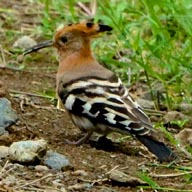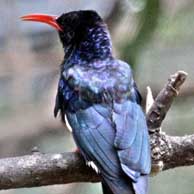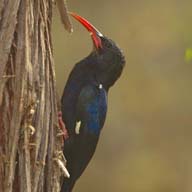
ComingsBirds.com/Birdgroups-G-L
To the Beauty of Birds
The Afrian Hoopoe /ˈhuːpuː/ (Upupa epops) is a colorful bird found across Afro-Eurasia, notable for its distinctive "crown" of feathers. It is the only extant species in the family Upupidae. Like the Latin name upupa, the English name is an onomatopoeic form which imitates the cry of the bird. The hoopoe is the national bird of Israel
The Hoopoe is classified in the clade Coraciiformes, which also includes kingfishers, bee-eaters, rollers, and woodhoopoes. A close relationship between the hoopoe and the woodhoopoes is also supported by the shared and unique nature of their stapes.
The fossil record of the hoopoes is very incomplete, with the earliest fossil coming from the Quaternary. The fossil record of their relatives is older, with fossil woodhoopoes dating back to the Miocene and those of an extinct related family, the Messelirrisoridae, dating from the Eocene.
The genus Upupa was created by Linnaeus in his Systema naturae in 1758. It then included three other species with long curved bills:
U. eremita (now Geronticus eremita), the northern bald ibis
U. pyrrhocorax (now Pyrrhocorax pyrrhocorax), the red-billed chough
U. paradisea
Nine subspecies of hoopoe are recognised by Kristin (in the 2001 Handbook of the Birds of the World). They vary mostly in size and the depth of color in the plumage. Two further subspecies have been proposed, U. e. minor in South Africa and U. e. orientalis in north western India.
The muscles of the head allow the Hoopoe's bill to be opened when it is inserted into the ground. The hoopoe is a medium sized bird, 9.8–12.6 in long, with a 17–19 in wingspan. The species is highly distinctive, with a long, thin tapering bill that is black with a fawn base. The strengthened musculature of the head allows the bill to be opened when probing inside the soil. The hoopoe has broad and rounded wings capable of strong flight; these are larger in the northern migratory subspecies. The hoopoe has a characteristic undulating flight, which is like that of a giant butterfly, caused by the wings half closing at the end of each beat or short sequence of beats.
The hoopoe is widespread in Europe, Asia, and North Africa, Sub-Saharan Africa and Madagascar. Most European and north Asian birds migrate to the tropics in winter. In contrast, the African populations are sedentary all year.
The Hoopoe has two basic requirements of its habitat: bare or lightly vegetated ground on which to forage and vertical surfaces with cavities (such as trees, cliffs or even walls, nestboxes, haystacks, and abandoned burrows) in which to nest. These requirements can be provided in a wide range of ecosystems, and as a consequence the Hoopoe inhabits a wide range of habitats such as heathland, wooded steppes, savannas and grasslands, as well as forest glades. The Madagascar subspecies also makes use of more dense primary forest. The modification of natural habitats by humans for various agricultural purposes has led to hoopoes becoming common in olive groves, orchards, vineyards, parkland and farmland, although they are less common and are declining in intensively farmed areas.
The diet of the hoopoe is mostly composed of insects, although small reptiles, frogs and plant matter such as seeds and berries are sometimes taken as well. It is a solitary forager which typically feeds on the ground. More rarely they will feed in the air, where their strong and rounded wings make them fast and maneuverable, in pursuit of numerous swarming insects. More commonly their foraging style is to stride over relatively open ground and periodically pause to probe the ground with the full length of their bill. Insect larvae, pupae and mole crickets are detected by the bill and either extracted or dug out with the strong feet. Hoopoes will also feed on insects on the surface, probe into piles of leaves, and even use the bill to lever large stones and flake off bark. Common diet items include crickets, locusts, beetles, earwigs, cicadas, ant lions, bugs and ants. These can range from 10 to 150 mm in length, with a preferred prey size of around 20–30 mm. Larger prey items are beaten against the ground or a preferred stone to kill them and remove indigestible body parts such as wings and legs.
Hoopoes are monogamous, although the pair bond apparently only lasts for a single season, and territorial. The male calls frequently to advertise his ownership of the territory. Chases and fights between rival males (and sometimes females) are common and can be brutal. Birds will try to stab rivals with their bills, and individuals are occasionally blinded in fights. The nest is in a hole in a tree or wall, and has a narrow entrance. It may be unlined, or various scraps may be collected.
Hoopoes have well-developed anti-predator defences in the nest. The uropygial gland of the incubating and brooding female is quickly modified to produce a foul-smelling liquid, and the glands of nestlings do so as well. These secretions are rubbed into the plumage. The secretion, which smells like rotting meat, is thought to help deter predators, as well as deter parasites and possibly act as an antibacterial agent. The secretions stop soon before the young leave the nest. From the age of six days, nestlings can also direct streams of faeces at intruders, and will hiss at them in a snake-like fashion. The young also strike with their bill or with one wing.
The diet of the hoopoe includes many species considered by humans to be pests, such as the pupae of the processionary moth, a damaging forest pest. For this reason the species is afforded protection under the law in many countries.
Hoopoes are distinctive birds and have made a cultural impact over much of their range. They were considered sacred in Ancient Egypt, and were "depicted on the walls of tombs and temples". They achieved a similar standing in Minoan Crete.
In the Bible, Leviticus 11:13–19, hoopoes were listed among the animals that are detestable and should not be eaten. They are also listed in Deuteronomy (14:18[20]) as not kosher.
Hoopoes also appear in the Quran, in Surah Al-Naml 27:20–22: "And he Solomon sought among the birds and said: How is it that I see not the hoopoe, or is he among the absent? I verily will punish him with hard punishment or I verily will slay him, or he verily shall bring me a plain excuse. But he [the hoopoe] was not long in coming, and he said: I have found out (a thing) that thou apprehendest not, and I come unto thee from Sheba with sure tidings." Islamic literature also states that a Hoopoe saved Moses and the children of Israel from being crushed by the giant Og after crossing the Red Sea.
Hoopoes were seen as a symbol of virtue in Persia. A Hoopoe was the leader of the birds in the Persian book of poems The Conference of the Birds.
Hoopoes were thought of as thieves across much of Europe, and harbingers of war in Scandinavia. In Estonian tradition, hoopoes are strongly connected with death and the underworld; their song is believed to foreshadow death for many people or cattle.
The Hoopoe was chosen as the national bird of Israel in May 2008 in conjunction with the country's 60th anniversary, following a national survey of 155,000 citizens, outpolling the white-spectacled bulbul. It is the state bird of the Punjab province of India. The hoopoe appears on the Logo of the University of Johannesburg and is the official mascot of the University's sports. The municipality of Armstedt, Germany, has a Hoopoe in its coat of arms.
Wikipedia
Genus: Phoeniculus
Green Wood Hoopoe, Phoeniculus purpureus
Violet Wood Hoopoe, Phoeniculus damarensis
Black-billed Wood Hoopoe, Phoeniculus somaliensis
White-headed Wood Hoopoe, Phoeniculus bollei
Forest Wood Hoopoe, Phoeniculus castaneiceps
Genus: Rhinopomastus
Black Scimitarbill, Rhinopomastus aterrimus
Common Scimitarbill, Rhinopomastus cyanomelas
Abyssinian Scimitarbill, Rhinopomastus minor



